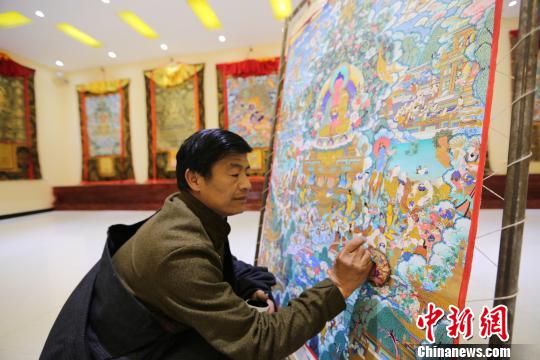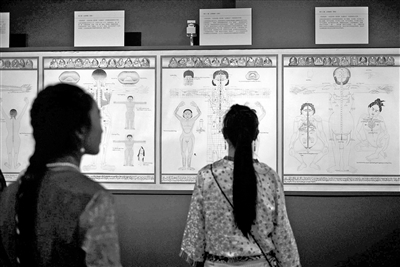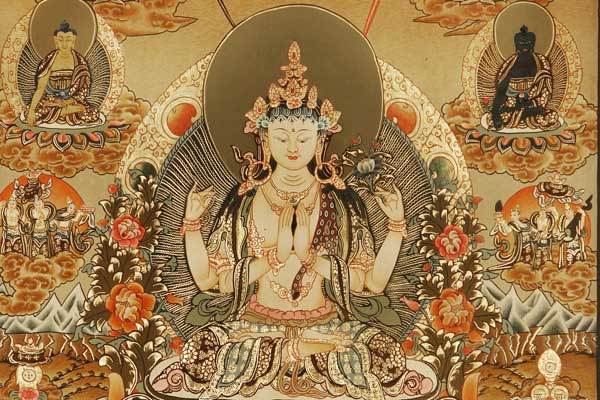Ways of appraising Tibetan Thangka art

When it comes to artifacts from Tibet, Thangka art is definitely one of the top choices. Thangka is a form of art first made popular during the Songtsen Gampo era, it is a type of scroll painting mounted with colored satin. Thangka has a distinctive ethnic character, has rich religious meaning, and shows a unique artistic vision. Treasured throughout the ages, Thangka is an art form born from Tibetan culture. The subject of Thangka varies, and takes inspiration from history, culture, religion, everyday life, and many other areas; it is heralded as the pride of Chinese folk art.
In a piece of Thangka art, the main artwork could be made by the apprentice, but the most challenging parts, such as the eyes, nails, hands, and any accessories and artifacts worn by the human subjects are mostly done by the master artist. When purchasing Thangka, it is essential to pay attention to these details. Some Thangkas have a layer of wax added after creation to keep its exterior and colors shinier and smoother, as well as to protect the art itself. It is a good idea to view the art under sunlight to check the complete coverage of the wax.
First, take a look at the subject of the art. Thangka involves many types of subjects, some of which may not be understandable to you. It is advisable to pick the ones more well-known in the market, such as the Buddha, the White Tara, the Green Tara, the God of Wealth, and other easily-acceptable and well-known figures.
Second, because Thangka takes a long time to create and involves detailed work, a larger piece would also cost more. For industry outsiders, the “level of expertise” and the “size of art” are the basic criteria in deciding what to purchase. It is a good idea to compare frequently and consider the following factors:
Influence from the master artist: Ever since ancient times, creating Thangka is a part of the training for believers of Buddhism. Temple Lamas are also the main creators of Thangka. Thangka art created by Lamas are circulated in relatively fewer channels and cost more.
Influence of the artistic expertise: The level of expertise has to do with accumulated experience, such as whether the colors are evenly mixed, whether details are carefully and completely done, the ratio of different parts of the artwork, whether there is any color-bleeding, missing colors, the organization of the entire artwork, etc.
The subjects of Thangka art cover everything under the sun, there is religious art, biographical art, historical art, folk art portraying lifestyles, and scientific art showing astronomy, Tibetan healing and medicine, and human body diagrams, etc. Thangka art is accessible, interesting, educational, religious, and finely-crafted, which is why it is known as the Tibetan encyclopedia. Before you purchase Thangka, it is a good idea to ask and learn as much as you can to ensure a satisfying experience.
Your Comment
Name E-mailRelated News
-
;
-
-

-
The Four-Volume Medical Code opened to public via Thangkas
Recently, “The Four-Volume Medical Code Mantang Long Volume –Nyangbon Thangka Art Inheritance Achievement Exhibition” was opened at the China National Museum.
-
-
-

-
Tibet to classify Thangka paintings
The “Thangka Classification Regional Standard” has gone through expert technical review, and will be implemented throughout Tibet.
-
-
-

-
Thangka worship activity held in Lhasa, China's Tibet
Buddhism followers attend a Thangka worship activity in the Tsurphu Monastery in Lhasa, capital of southwest China's Tibet Autonomous Region, June 16, 2016.
-
Based in Lhasa, Tibet Vista is a Tibet travel agency that specialized in Tibet permit, and Tibet tours for both private and group travelers at a local price!
•4 Days Lhasa City Group Tour from USD 460 •8 Days Everest Base Camp Group Tour from USD 850 •15 Days Mt.Kailash Group Tour from USD 1780 •2016 Tibet Train Tours from Beijing, Shanghai, Chengdu, Xining,etc










